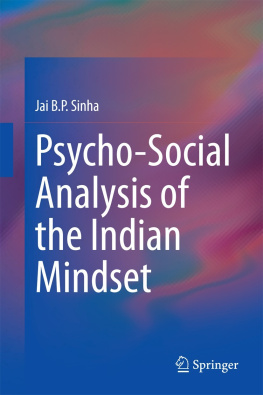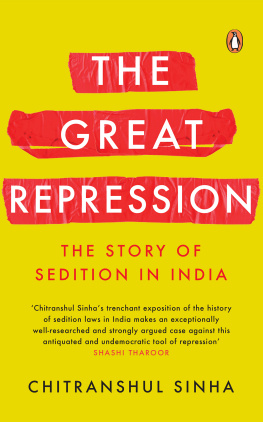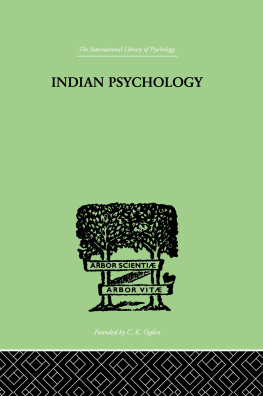1.1 The Mindset and the Milieu
The Indian mindset refers to shared images that Indians have of themselves, which orient them to make sense of and react to their immediate milieu consisting of other persons, objects, ideas and events. The shared images could range from highly positive (e.g. being optimistic, confident, creative and superior) to largely negative (e.g. being pessimistic, self-abnegating, inferior and frustrated) or various shades in between the two. Positive images lead Indians to approach the milieu proactively, engaging it fruitfully, while negative ones turn people defensive, withdrawn, cynical, aggressive and so on. The images are composed of assumptions, beliefs, values, norms and practices that people acquire in the process of interacting with the milieu. Beliefs are the understanding of how things happen (e.g. God created this world) or are related to each other (e.g. spirituality brings peace of mind). Beliefs that are in the subconscious are assumptions that are taken for granted and are not proved or disproved (e.g. God exists). Values are the importance attached to or preference for persons (e.g. father), objects (e.g. money), ideas (spirituality) or events (e.g. festivals). Norms are standards to judge what is appropriate (e.g. politeness to seniors) or what most people do in a particular situation (stop at a red light traffic signal, respect ones father). They are overlapping and interrelated, constituting a mindset.
A milieu is the representation of a culture as perceived by its people. Kluckhohn (). As a result, the Indian mindset has been in the making since ancient times.
1.2 Continuity Amidst Continuous Change in Culture and Mindset
Both the history of a culture and its peoples mindset maintain continuity while changing continuously. Continuity lies partly in the relatively lasting core features of the culture and partly in the inner layers of peoples mindset that orients them to interpret the milieu and act to it in familiar ways. Continuity provides a basis for identityrecognizable characteristics that essentially remain the same, similar or consistent over time. People prefer continuity because they can recognize the milieu easily on the basis of their past experiences and fashion their reactions to it with less uncertainty and risk of going wrong. Continuity creates a comfort zone to carry on everyday transactions in habitual ways without expending much energy or wasting time or other resources.
However, cultures are also open to pressures to change either because of their inner contradictions, external forces impinging upon them or most often the joint impact of both. Cultures are engaged in active and continuous interactions with the surrounding physical environment, exposed to major contemporary events, vulnerable to emerging threats, receptive to unfolding opportunities and open to unanticipated internal compulsions. As the environment is attended to, the events are acted upon, threats are coped with, opportunities are availed of and internal contradictions are reconciled, people are compelled to doubt their assumptions and beliefs, set or add new norms or modify existing ones, reinterpret or replace their old values, and think and behave differently. In other words, the mindset keeps getting modified and restructured by rearranging the existing components as well as incorporating new ones in order to enable people to adapt, survive and prosper in a changing milieu. If changes in the milieu are enabling, peoples mindsets ride on a positive trajectory by initiating progressive engagements. On the contrary, debilitating milieus dampen peoples spirit and put their mindsets on a downslide. Thus, peoples mindsets change as a function of their continuous interactions with the surrounding cultural milieu.
Over and above this universal nature of milieumindset relationship, there is an additional source of continuity and change in the Indian culture and mindset. The continuity is rooted in the belief that the ancient wisdom enshrined in the Vedas and Upanishads is valid for all time. The belief is that though the changes that are experienced in everyday life are realities, they are phenomenal ( maaya ). The essence beneath such realities does not change. It is the Ultimate Reality that permeates and appears in the changing manifestations.
In other words, the changing milieu is indeed an apparent reality that is experienced and has to be lived in, but with the realization that it is essentially the varied expressions of the unchanging core reality. That is why the oldest of the Indian scriptures, the Rig Veda (1,500 BCE), pronounced that wise men construe one and the same truth in different ways ( Rig Veda , 1.164.46). The Upanishads repeated this belief that there are many paths to the truth, or as Lord Krishna preached in the Bhagavad Gita , All paths lead to me.
Once this seeming contradiction between the core of an unchanging ultimate reality and its changing and varied manifestations is reconciled, it is not illogical to hold a pluralistic worldview in tandem with the validity of ancient wisdom soliciting new ideas and influences. The Rig Veda itself proclaimed: Let noble thoughts come to us from all directions (1.89.9). Historical evidence also suggested that Indians indeed recognized, received and accepted new ideas and influences arising out of internal sources such as political upheavals, social transformation and economic prosperity as well as external ones emanating from migrations, invasions and alien rules. The Indian subcontinent has subsumed most of them into indigenous cultural traditions.
As a result, the cultural traditions, though they became diverse, were retained over time. Thapar () further specified that the continuity in Indian traditions is unparalleled in the world, In respect of the length of continuous tradition, China comes second to India, and Greece makes a poor third (p. 3).
Such remarkable continuity of tradition, as exemplified by these works [paintings and sketches] of nomadic tribesmen and cattle herders, is to be found in most of the rural culture of the sub-continentendorsing the claim that Indians live in more centuries at the same time than most other peoples (Lannoy , p. 5).
Naturally, the mindset embodied from ancient time a variety of ideas and influences that were accommodated within the overarching indigenous pluralistic worldview. Lannoy further commented that the Indian way of borrowing while conserving, of juxtaposing the new and the old in hierarchical relations, would seem to originate in this great racial interaction nearly four thousand years ago (p. 13).
There were four major psychic mechanisms that tended to maintain continuity from the ancient Indian thought while accommodating new ideas and influences under the impact of changing cultural milieu.
1.2.1 Adding New Ideas and Influences to the Old
Jawaharlal Nehru, Indias first Prime Minister, described India as an ancient palimpsest on which layer upon layer of thought and reverie had been inscribed, and yet no succeeding layer had completely hidden or erased what had been written previously (Nehru , p. xvi).
The new thoughts and actions were considered to be essential for addressing to the contemporary threats and opportunities, but were interpreted and taken to be an elaboration of the already existing ways that were enshrined in the ancient wisdom. Thus, the new was not a substitute but a recreation of the old. Radhakrishnan and Moore () observed:











